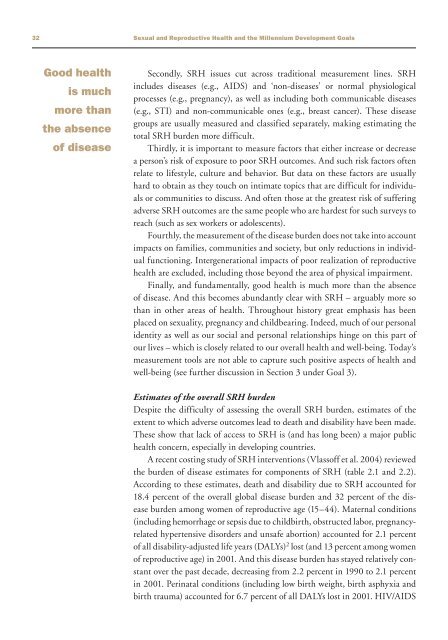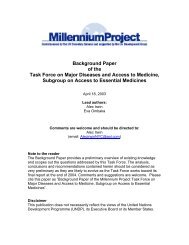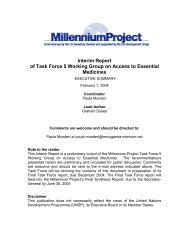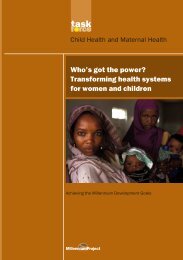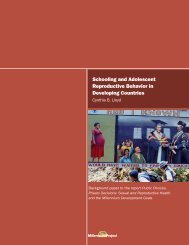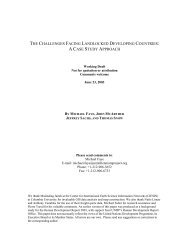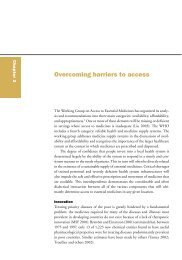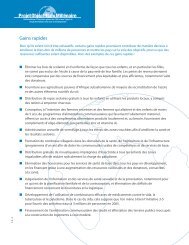Public Choices, Private Decisions: Sexual and Reproductive Health ...
Public Choices, Private Decisions: Sexual and Reproductive Health ...
Public Choices, Private Decisions: Sexual and Reproductive Health ...
You also want an ePaper? Increase the reach of your titles
YUMPU automatically turns print PDFs into web optimized ePapers that Google loves.
32 <strong>Sexual</strong> <strong>and</strong> <strong>Reproductive</strong> <strong>Health</strong> <strong>and</strong> the Millennium Development Goals<br />
Good health<br />
is much<br />
more than<br />
the absence<br />
of disease<br />
Secondly, SRH issues cut across traditional measurement lines. SRH<br />
includes diseases (e.g., AIDS) <strong>and</strong> ‘non-diseases’ or normal physiological<br />
processes (e.g., pregnancy), as well as including both communicable diseases<br />
(e.g., STI) <strong>and</strong> non-communicable ones (e.g., breast cancer). These disease<br />
groups are usually measured <strong>and</strong> classified separately, making estimating the<br />
total SRH burden more difficult.<br />
Thirdly, it is important to measure factors that either increase or decrease<br />
a person’s risk of exposure to poor SRH outcomes. And such risk factors often<br />
relate to lifestyle, culture <strong>and</strong> behavior. But data on these factors are usually<br />
hard to obtain as they touch on intimate topics that are difficult for individuals<br />
or communities to discuss. And often those at the greatest risk of suffering<br />
adverse SRH outcomes are the same people who are hardest for such surveys to<br />
reach (such as sex workers or adolescents).<br />
Fourthly, the measurement of the disease burden does not take into account<br />
impacts on families, communities <strong>and</strong> society, but only reductions in individual<br />
functioning. Intergenerational impacts of poor realization of reproductive<br />
health are excluded, including those beyond the area of physical impairment.<br />
Finally, <strong>and</strong> fundamentally, good health is much more than the absence<br />
of disease. And this becomes abundantly clear with SRH – arguably more so<br />
than in other areas of health. Throughout history great emphasis has been<br />
placed on sexuality, pregnancy <strong>and</strong> childbearing. Indeed, much of our personal<br />
identity as well as our social <strong>and</strong> personal relationships hinge on this part of<br />
our lives – which is closely related to our overall health <strong>and</strong> well-being. Today’s<br />
measurement tools are not able to capture such positive aspects of health <strong>and</strong><br />
well-being (see further discussion in Section 3 under Goal 3).<br />
Estimates of the overall SRH burden<br />
Despite the difficulty of assessing the overall SRH burden, estimates of the<br />
extent to which adverse outcomes lead to death <strong>and</strong> disability have been made.<br />
These show that lack of access to SRH is (<strong>and</strong> has long been) a major public<br />
health concern, especially in developing countries.<br />
A recent costing study of SRH interventions (Vlassoff et al. 2004) reviewed<br />
the burden of disease estimates for components of SRH (table 2.1 <strong>and</strong> 2.2).<br />
According to these estimates, death <strong>and</strong> disability due to SRH accounted for<br />
18.4 percent of the overall global disease burden <strong>and</strong> 32 percent of the disease<br />
burden among women of reproductive age (15–44). Maternal conditions<br />
(including hemorrhage or sepsis due to childbirth, obstructed labor, pregnancyrelated<br />
hypertensive disorders <strong>and</strong> unsafe abortion) accounted for 2.1 percent<br />
of all disability-adjusted life years (DALYs) 2 lost (<strong>and</strong> 13 percent among women<br />
of reproductive age) in 2001. And this disease burden has stayed relatively constant<br />
over the past decade, decreasing from 2.2 percent in 1990 to 2.1 percent<br />
in 2001. Perinatal conditions (including low birth weight, birth asphyxia <strong>and</strong><br />
birth trauma) accounted for 6.7 percent of all DALYs lost in 2001. HIV/AIDS


